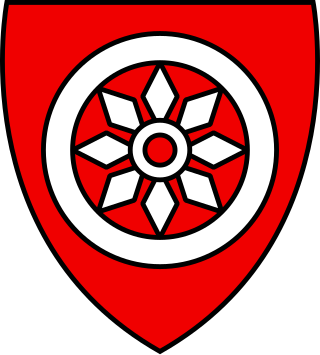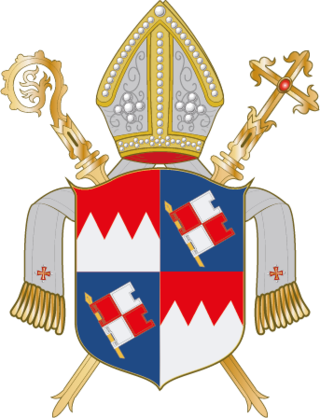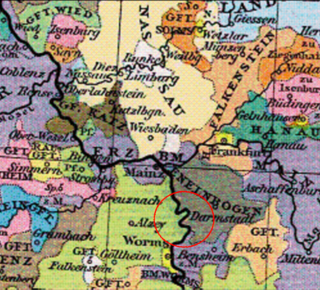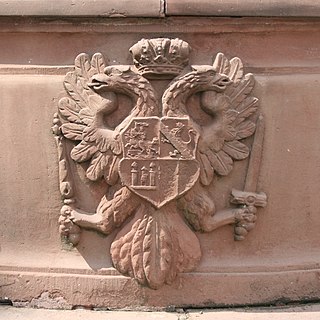
Rheinböllen is a town in the Rhein-Hunsrück-Kreis (district) in Rhineland-Palatinate, Germany. It belongs to the Verbandsgemeinde Simmern-Rheinböllen, whose seat is in Simmern. It was the seat of the former Verbandsgemeinde Rheinböllen.

The Elector of Mainz was one of the seven Prince-electors of the Holy Roman Empire. As both the Archbishop of Mainz and the ruling prince of the Electorate of Mainz, the Elector of Mainz held a powerful position during the Middle Ages. The Archbishop-Elector was president of the electoral college, archchancellor of the empire, and the Primate of Germany as the papal legate north of the Alps, until the dissolution of the empire in 1806.

The Diocese of Würzburg is a Latin Church diocese of Catholic Church in Germany. The diocese is located in Lower Franconia, around the city of Würzburg, and the bishop is seated at Würzburg Cathedral. Founded in 741, the diocese lost all temporal power after the Napoleonic wars.

The House of Franckenstein is the name of a feudal, Franconian noble family in Germany, descendants from the Dynasts of the Breuberg family; offsprings of the Lords of Lützelbach from Höchst im Odenwald.

The Liebenau monastery was a Dominican monastery. It was located outside the city gates of Worms in today's Worms-Hochheim district.

The Lordship of Franckenstein was a historical territory in the northern Odenwald. It originated around 1230 from the possessions of the Breuberg, whose center was Frankenstein Castle. Konrad II of Breuberg and his wife Elisabeth of Weiterstadt called themselves Frankenstein after having build the castle henceforth. The dominion remained as condominium in the possession of the family until the year 1662. After the sale by the Frankensteis to Landgrave Louis VI, Landgrave of Hesse-Darmstadt, it came into the possession of Hesse-Darmstadt.

The County of Steinfurt, originally the Lordship of Steinfurt, was a historic territory of the Holy Roman Empire in the Munsterland. It existed from roughly 1100 until 1806.

The Burgraviate of Friedberg was a territory within the Holy Roman Empire. It emerged during the Late Middle Ages from the Burgmannschaft of Reichsburg Friedberg in Hesse. Notably, the Burgraviate featured a cooperative constitutional structure and was endowed with manorial privileges by the Emperor, which were reaffirmed multiple times until its dissolution in 1806. The Burgraviate established its territory, which, in addition to overseeing the neighboring Reichsstadt Friedberg and the Freigericht Kaichen, included a narrow strip of land in the southern Wetterau. Consequently, Friedberg Castle can be regarded as the sole reichsständische castle since its inclusion in the Reichsmatrikel in 1431. According to its self-perception, the Kayserliche und des heiligen Reichs-Burg Friedberg, as it was called, was a prominent institution of the Imperial Knighthood and directly subordinate to the king or emperor.

Clemens August, Freiherr von Westphalen zu Fürstenberg was a German aristocrat who held numerous offices in various North-West German Bishoprics and served as Minister of State of the Electorate of Mainz and Imperial Envoy.
Philipp Erwein, Freiherr von Schönborn zu Freienfels-Eschbach, was a German nobleman who is considered the founder of the economic success of the Counts of Schönborn.

Hugo Damian Friedrich Karl Franz Erwein von Schönborn-Wiesentheid, was a German chamberlain and member of the counsel from Aschaffenburg. He was Count of Wiesentheid from 1772 to 1806. After the dissolution of the county he withdrew to his estates in Vienna.














